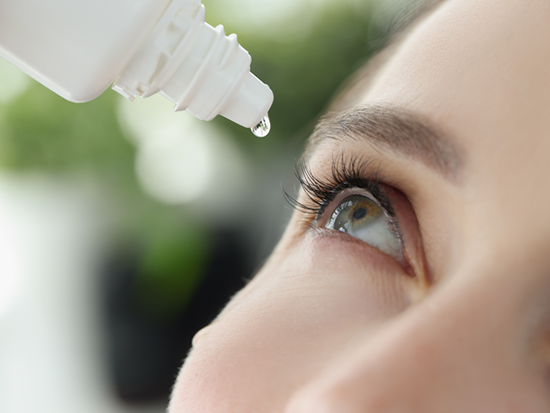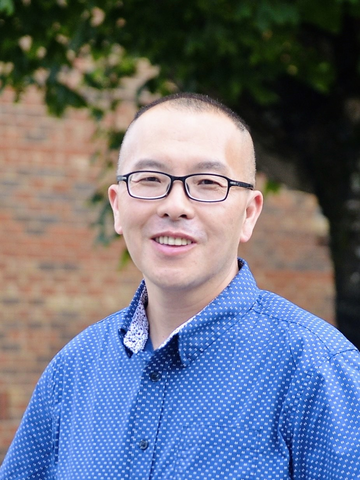Media contact: Anna Jones
 This new technology developed by researchers in the UAB School of Optometry will allow for non-invasive assessments for DED and inform the development of new treatments for DED.Dry eye disease occurs when tears do not provide adequate lubrication for the eyes. It affects approximately 20 million people in the United States, according to the American Academy of Ophthalmology. Yuqiang Bai, Ph.D., a researcher at the University of Alabama at Birmingham School of Optometry, has received a $1.85 million R01 grant from the National Institutes of Health to study dry eye disease. The research will allow for non-invasive assessments for dry eyes and inform the development of new treatments. Bai, along with Jason Nichols, O.D., Ph.D., UAB optometry professor, invented new technology to aid his research.
This new technology developed by researchers in the UAB School of Optometry will allow for non-invasive assessments for DED and inform the development of new treatments for DED.Dry eye disease occurs when tears do not provide adequate lubrication for the eyes. It affects approximately 20 million people in the United States, according to the American Academy of Ophthalmology. Yuqiang Bai, Ph.D., a researcher at the University of Alabama at Birmingham School of Optometry, has received a $1.85 million R01 grant from the National Institutes of Health to study dry eye disease. The research will allow for non-invasive assessments for dry eyes and inform the development of new treatments. Bai, along with Jason Nichols, O.D., Ph.D., UAB optometry professor, invented new technology to aid his research.
“Discomfort created by the condition causes substantial physical, financial and psychological consequences,” Bai said. “The grant will allow us to use the technology that Dr. Nichols and I created to get a high-resolution view of the eye that provides information about the tear film health.”
The grant
In his research, Bai will be looking at the tear film, which is the mechanism in the eye that produces tears that keep the eye moist. The research will look at the thickness of the tear film and whether it is associated with dry eyes. Bai and his team hypothesize that “thin” regions of the tear film allow for excessive loss of tears needed to lubricate the eye. The purpose of this grant is to develop a better understanding of the underlying causes of dry eye disease and to identify signs and symptoms associated with the development of dry eye that can be used for early diagnosis, prognosis and monitoring of treatment response.
 Yuqiang Bai, Ph.D., a researcher at the University of Alabama at Birmingham School of Optometry has received a $1.85 million R01 from the National Institutes of Health. “The objective is to comprehensively study the physical properties of tear film, such as its thickness dynamics, viscosity and osmolarity and their relationship to dry eye disease,” Bai said. “This work will take full advantage of my knowledge and background in physics and optics, along with my expertise in biomedical imaging.”
Yuqiang Bai, Ph.D., a researcher at the University of Alabama at Birmingham School of Optometry has received a $1.85 million R01 from the National Institutes of Health. “The objective is to comprehensively study the physical properties of tear film, such as its thickness dynamics, viscosity and osmolarity and their relationship to dry eye disease,” Bai said. “This work will take full advantage of my knowledge and background in physics and optics, along with my expertise in biomedical imaging.”
Treatment options are currently considered only after a patient is symptomatic or palliative care options, such as masks or over-the-counter eye drops, fail to provide long-lasting relief. Some in-office mechanical therapies target the meibomian glands, which are the glands around the eyelashes that make oil needed for tears. Along with the aqueous partition, the glands form a thin layer over the top of tear film and play a significant role in keeping eyes lubricated and preventing dryness. Despite a handful of therapies, no treatments address the underlying issues with the tear film that may lead to dry eye.
The technology
Bai and Nichols developed a new interferometer — an innovative device that uses a laser beam to generate interference patterns within the layers of the surface of the cornea. An interference pattern occurs when two or more light waves interact with each other. By looking at the pattern, researchers can determine the thickness of the tear film and can help evaluate tear film quality and identify any irregularities, including aspects related to tear film spread and formation following blinks, as well as how it acts in between blinks. The interferometer is used in a non-invasive procedure and does not require the use of contact lenses or dyes.
 Bai, along with Jason Nichols, O.D., Ph.D., UAB optometry professor, invented new technology to aid his research.“With the knowledge and experience in physics, optics and related imaging systems, we have developed the new interferometer with a state‐of‐the‐art laser source and high‐speed line scan camera, a specialized post‐processing algorithm based on modern technology,” Bai said. “The new device breaks through the limits of current methodologies and puts new insights into the human tear film and its lipid layer — the outmost layer of the tear film. With the aid of the device, the work in this grant will bridge this knowledge gap and determine the relationship between the tear film and the lipid layer’s microstructure and function.”
Bai, along with Jason Nichols, O.D., Ph.D., UAB optometry professor, invented new technology to aid his research.“With the knowledge and experience in physics, optics and related imaging systems, we have developed the new interferometer with a state‐of‐the‐art laser source and high‐speed line scan camera, a specialized post‐processing algorithm based on modern technology,” Bai said. “The new device breaks through the limits of current methodologies and puts new insights into the human tear film and its lipid layer — the outmost layer of the tear film. With the aid of the device, the work in this grant will bridge this knowledge gap and determine the relationship between the tear film and the lipid layer’s microstructure and function.”
Due to the prevalence of the disease, in 2020, the National Eye Institute issued a Notice of Special Interest highlighting a critical need for methods to diagnose dry eye before the onset of symptoms. Bai’s study will address several of the concerns cited in the NEI’s notice.
“The grant is an interdisciplinary dry eye research, in which we will not only apply the new best tools but also produce novel insights and make unique contributions from the viewpoints of physics,” Bai said.
Along with the new interferometric technique, Bai’s early-stage training as a physicist and engineer provides a unique, non-conventional perspective to decipher the pathogenesis of dry eye disease. The current R01 project is expected to advance understanding of the mechanisms and help guide compositional alterations in various therapeutics for dry eye.